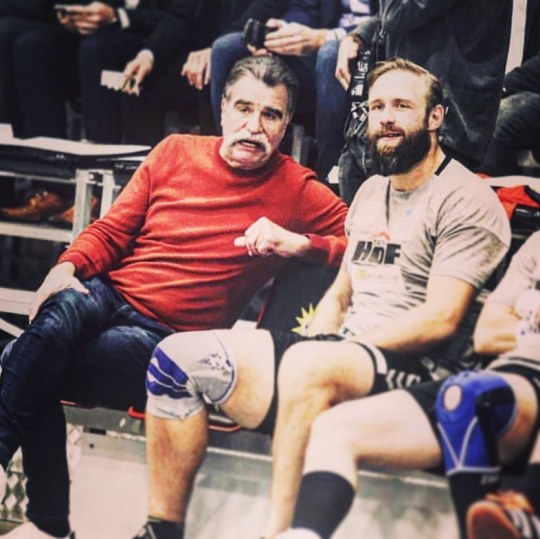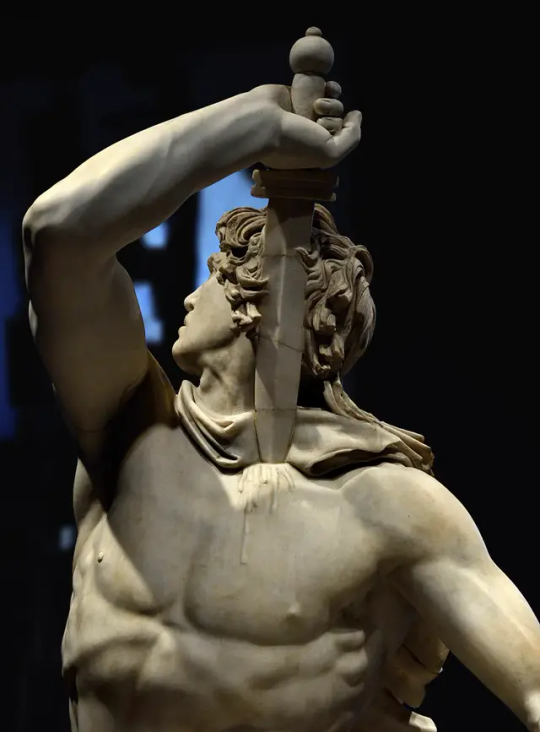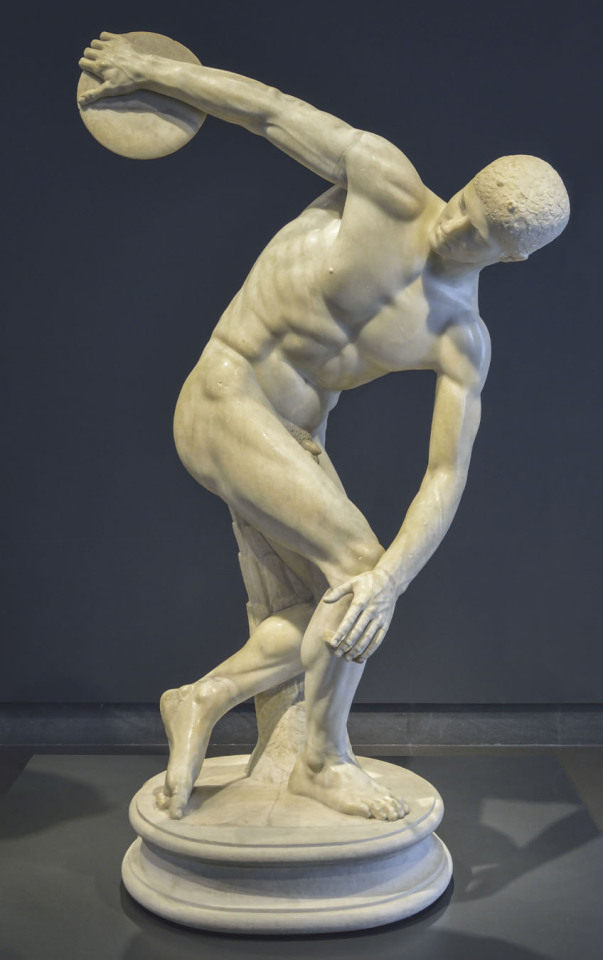#Discus thrower
Text

Stephan Vladislavovich Bakałowicz (Polish, 1857-1947)
Discus thrower, 1889
Omsk Regional Museum of Fine Arts named after. M.A.Vrubel
#Stephan Vladislavovich Bakałowicz#polish art#polish#discus thrower#1800s#art#fine art#european art#classical art#europe#european#oil painting#fine arts#europa#mediterranean#southern europe#cradle of civilization#painting#artwork#male#western civilization
311 notes
·
View notes
Text

N. Dumbadze, discus thrower 1950s
40 notes
·
View notes
Text

THE DISCOBOLUS (DISCUS-THROWER) | 450 BCE | by MYRON
THE DISCOBOLUS is a renowned GREEK sculpture depicting an athlete about to throw a discus. It is considered one of the masterpieces of classical GREEK art and a testament to the skill and artistry of the sculptor, MYRON.
The sculpture captures the athlete in a mid-throw, with his body coiled and poised in anticipation. His left arm is drawn back, ready to release the discus. The figure is rendered with an incredible sense of movement and tension, as if frozen in time. MYRON employed a technique revealing the underlying musculature. This technique showcased MYRON'S mastery of anatomy and the ability to convey movement through the depiction of form.
THE DISCOBOLUS is also notable for its use of contraposto, a pose where the weight of the body is shifted to one leg, creating a dynamic and asymmetrical composition. This technique emphasizes the athlete's athleticism and the tension in his body as he prepares to throw.
THE DISCOBOLUS celebrates the physical prowess and athleticism of the GREEKS. It encapsulates the spirit of competition and the pursuit of excellence that was so important to GREEK culture. Beyond its athletic and aesthetic significance, THE DISCOBOLUS has also been interpreted as a symbol of balance, harmony, and the pursuit of perfection. It represents the ideals of classical GREECE and continues to inspire awe and admiration in viewers today.
0 notes
Text

27 notes
·
View notes
Text

#J C Leyendecker - The Discus Thrower#The American Victory at Athens#Collier's Weekly magazine cover#(1906)
62 notes
·
View notes
Text
life imitates art


anyway.
#f1 hyperfixation interuppting my studies once again.#myrons discus thrower my beloved#also kimis there#kimi raikkonen#formula 1
20 notes
·
View notes
Text









Robert Harting
sources:
deutschlandfunk
gala
promiflash
tagesspiegel
spiegel
facebook
t-online
18 notes
·
View notes
Text
I'm watching women's discus throwing. For the plot.
#Feng Bin discus thrower from China will you marry me#Also my long jump favourite isn't competing this year#She's our pride and joy#macks musings#Sports
7 notes
·
View notes
Photo

Rachel Dincoff, USA, Olympian, Discus. .. . . . . #racheldincoff #usatf #discus #olympian #trackandfield #athletics #jeffcohenphoto #trackportraits #thrower @raydinc @usatf https://www.instagram.com/p/CnU61RWPe98/?igshid=NGJjMDIxMWI=
16 notes
·
View notes
Text
y’all i need to get out and work on throwing but it’s like 100° outside
#taylor swift#speak now#t.s. 1989#taylornation#taylor swizzle#taylors version#taylor’s version#twitter swiftie#evermore#folklore#thrower#discus#shotput
6 notes
·
View notes
Text

#animated gif#animated gifs#gif#gifs#old advertisements#old ads#retro#vhs#animation#animated#cartoon#neon#discus#disc thrower#sparkly#shiny#lens flare#steven universe
4 notes
·
View notes
Text
If Valerie Allman and Sandra Perković threw me 67+ meters i would thank em
1 note
·
View note
Text

slams it shut and throws it into the ocean at the speed of an olympic discus thrower
521 notes
·
View notes
Text
TIME TO POUND OUT THESE LAST THREE TRACK MEETS IN FOUR DAYS LETS DO THIS SHIT
I love how he started out this season as a
“I will never run. I will not set foot on the track. I am not going to touch baton. I will not even look at a 100m!”
And now I’m like
“All right a 400m? Sure! I’m ready! 200m? sure! I’ll run a 100! Long jump? fuck yeah! high jump? still no😅. triple jump? Hell yeah! what the fuck do you want me to do? if it’s less than an 800m, I’ll do it.”
And that’s what we call character development
#track and field#sprinter#thrower#discus#shot put#javelin#aubrey/alex says shit#ben talks volleyball#but it’s track this time
1 note
·
View note
Text
Let's Play: What's Wrong with this Sculpture?
Following in the theme of sharing astonishing moments of ancient sculpture pedantry here on Tumblr, based on my brief undergraduate stint as a T.A of ancient art history, I thought I'd share one of my other proudest moments of being an absolutely insufferable know-it-all about ancient sculptures.
In the process, I hope I can also share some of the sort of largely useless (from a practical perspective) information that Tumblr tends to glory in, so buckle up buttercups.
This question was posed to me on a walking tour of the Capitoline Museum in my ancient art history class while I was living abroad. Our professor, a delightfully curmudgeonly Belgian, stopped in front and asked us to figure out why this sculpture is just plain wrong.
I intend to walk you through the process of how I got the right answer and, after gaining my teacher's rare approval, glowed with enough serotonin to power a small nuclear reactor.
So, let's return to the original question: what is wrong with this sculpture?
Because if you are truly eagle-eyed you should be able to spot what very famous sculpture this actually is, before an overly imaginative Frenchman brought it back wrong.

Hint #1: It was incorrectly restored.
Look closely at the the difference of the patina, or color of the stone. It's a bit hard to tell in this photo, but the head was added later. It's a paler white than the core of the torso, which is what we have of the original sculpture.
Hint #2: It was incorrectly restored in the 18th century by a Frenchman (Pierre-Étienne Monnot) who made some, shall we say, creative interpretations of what's going on here.
You can tell it's by an 18th c. Frenchman because the facial features are so delicate. Ancient statues tend to have less narrow and delicate chins and noses. In general, that is a dead giveaway when something is 18th century French vs. Ancient Greek or Roman.


Here's a good example. The first sculpture is 18th c. French, the second is the famous Venus de Milo. Note her blockier chin and less delicate features. So in the future, you can tell these sort of later additions to Greek or Roman sculptures if they added a new head because 17-19th century sculptors in Europe had tools (like finer drill tips) and tastes (beauty standards that favored more delicate men and women) that led to a pronounced difference in the faces.
Hint #3: Check out the anatomy of his lower shoulder. That's another addition, that arm should not be coming straight out of a torso where the muscle, if you look closely, is turned inward.
Seriously, that looks painful.
Hint #4: The sword he's holding up is just total nonsense for the Roman era. I mean, the restoration makes no secret of the fact that this sword is a later addition, but it's also just an absolute nonsense sword with its silly little curved cross guard. This Frenchman literally just made it up.
Here's an ancient sculpture with a sword in it that actually looks right:

From the Ludovisi Gaul, a famous Hellenistic Baroque work of Greek sculpture. Note the much blockier sword though I will admit, it could be a later addition, I don't know for 100% certain, but I'm pretty sure it's the original. Regardless, it fits the sculpture much better and let me add that sword I'm criticizing is completely made up for the sculpture we're talking about and is not there in the original sculpture that was incorrectly restored.
Ok, so those are all the hints.
Look closely at the body of the first sculpture. Cut away the arms that are not connected to the body correctly, the sword that shouldn't be there, the face that was far too delicate. When you separate those later additions out, can you tell me what sculpture that actually is?
Because here is the reveal!

The Discus Thrower, aka, the Discobolus by Myron.
The French restorationist got carried away by his own imagination, saw a twisted torso and thought it could only possibly be a warrior in the midst of twisting around to fend off a blow, not an athlete in the midst of a demonstration of skill. It's a martial, fanciful read that completely misinterpreted the subject.
This is why most restoration today employs a much lighter touch, rather than trying to reattach pieces incorrectly, they tend to just outline where the missing pieces are with a light sketch of an educated guess of what might have actually been there. Faulty restorations like the Capitoline Discobolus is one reason for this modern stylistic principle when it comes to restoration work.
When my professor asked us to identify the correct original sculpture that day on the museum tour, it was the sword that pinged me as wrong first, but zeroing in on the core of the sculpture, the torso, is what revealed the true statue underneath.
This notoriously difficult to please professor was very proud when I blurted out, "It's the Discus Thrower!" and the high-octane serotonin I got from his approval probably could have propelled me into the sun that day, and brought to you Yet Another Moment of Ancient Sculpture Pedantry.
#ancient history#ancient rome#art history#discobolus#there are very few things I'll brag about but naming this sculpture correctly is one of them#in part because there was so little to be gained lol oh well might as well make a tumblr post about it
227 notes
·
View notes